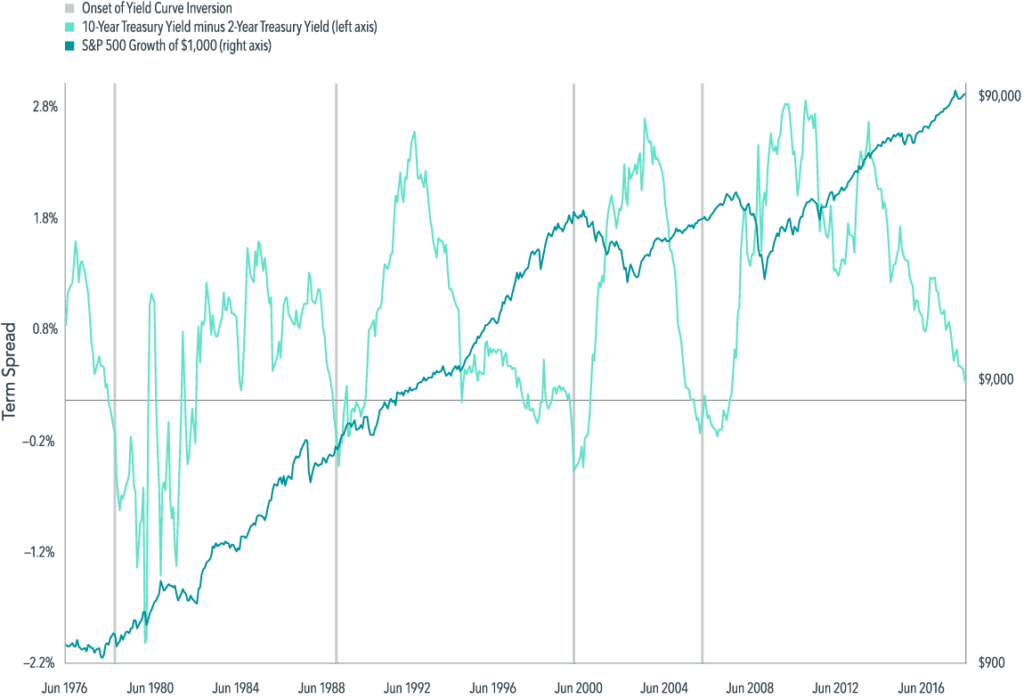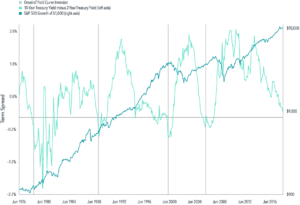I get asked a lot by non-clients what I think the stock market is going to do. I always tell these folks that I have no idea what it will do in the short run. Stock prices could drop dramatically. But in the long run, they go up.
Right now many people are worried about something called a yield curve inversion. This is a fancy phrase for when long term interest rates are lower than short term interest rates at a given time. Many recessions have been preceded by a yield curve inversion, and the yield curve is showing inversion right now.
Take a look at this graph from our friends at Dimensional Fund Advisors:
 This graph represents the year 1976 until September of last year. The dark blue line that goes up and to the right is the value of the S&P 500 Growth index (stock prices). The green squiggly line going up and down represents changes in the yield curve.
Good luck trying to use the green line to predict the blue one.
Finance people are always looking for clues, signs, any information to try to make predictions about the direction of markets, and most are unsuccessful at it.
Investors are better off figuring out how much of their portfolio should be in growth investments like stocks, and less time trying to predict the direction of the value of stocks. Predicting short-term stock market movements is like trying to make sense of the green squiggly line. It’s much easier to use the blue line.
The best thing that could happen to long-term investors who are saving (young people), is to have a steep market sell-off, where the market drops by 50%. They could spend the next several years buying one dollar bills for 50 cents. They’d have lots more money when they are older.
Investors with shorter time horizons or a lower risk tolerance should curtail the amount of their portfolio invested in stocks, and consider fixed income or other investments. That way, if we do have a recession, their accounts won’t decline as much in value.
We look forward to serving you.
*Thanks to Josh Brown for his ideas and blog which continue to shape my views:
This graph represents the year 1976 until September of last year. The dark blue line that goes up and to the right is the value of the S&P 500 Growth index (stock prices). The green squiggly line going up and down represents changes in the yield curve.
Good luck trying to use the green line to predict the blue one.
Finance people are always looking for clues, signs, any information to try to make predictions about the direction of markets, and most are unsuccessful at it.
Investors are better off figuring out how much of their portfolio should be in growth investments like stocks, and less time trying to predict the direction of the value of stocks. Predicting short-term stock market movements is like trying to make sense of the green squiggly line. It’s much easier to use the blue line.
The best thing that could happen to long-term investors who are saving (young people), is to have a steep market sell-off, where the market drops by 50%. They could spend the next several years buying one dollar bills for 50 cents. They’d have lots more money when they are older.
Investors with shorter time horizons or a lower risk tolerance should curtail the amount of their portfolio invested in stocks, and consider fixed income or other investments. That way, if we do have a recession, their accounts won’t decline as much in value.
We look forward to serving you.
*Thanks to Josh Brown for his ideas and blog which continue to shape my views:
 This graph represents the year 1976 until September of last year. The dark blue line that goes up and to the right is the value of the S&P 500 Growth index (stock prices). The green squiggly line going up and down represents changes in the yield curve.
Good luck trying to use the green line to predict the blue one.
Finance people are always looking for clues, signs, any information to try to make predictions about the direction of markets, and most are unsuccessful at it.
Investors are better off figuring out how much of their portfolio should be in growth investments like stocks, and less time trying to predict the direction of the value of stocks. Predicting short-term stock market movements is like trying to make sense of the green squiggly line. It’s much easier to use the blue line.
The best thing that could happen to long-term investors who are saving (young people), is to have a steep market sell-off, where the market drops by 50%. They could spend the next several years buying one dollar bills for 50 cents. They’d have lots more money when they are older.
Investors with shorter time horizons or a lower risk tolerance should curtail the amount of their portfolio invested in stocks, and consider fixed income or other investments. That way, if we do have a recession, their accounts won’t decline as much in value.
We look forward to serving you.
*Thanks to Josh Brown for his ideas and blog which continue to shape my views:
This graph represents the year 1976 until September of last year. The dark blue line that goes up and to the right is the value of the S&P 500 Growth index (stock prices). The green squiggly line going up and down represents changes in the yield curve.
Good luck trying to use the green line to predict the blue one.
Finance people are always looking for clues, signs, any information to try to make predictions about the direction of markets, and most are unsuccessful at it.
Investors are better off figuring out how much of their portfolio should be in growth investments like stocks, and less time trying to predict the direction of the value of stocks. Predicting short-term stock market movements is like trying to make sense of the green squiggly line. It’s much easier to use the blue line.
The best thing that could happen to long-term investors who are saving (young people), is to have a steep market sell-off, where the market drops by 50%. They could spend the next several years buying one dollar bills for 50 cents. They’d have lots more money when they are older.
Investors with shorter time horizons or a lower risk tolerance should curtail the amount of their portfolio invested in stocks, and consider fixed income or other investments. That way, if we do have a recession, their accounts won’t decline as much in value.
We look forward to serving you.
*Thanks to Josh Brown for his ideas and blog which continue to shape my views:
How Young Investors Should Think About Yield Curves and Recessions


